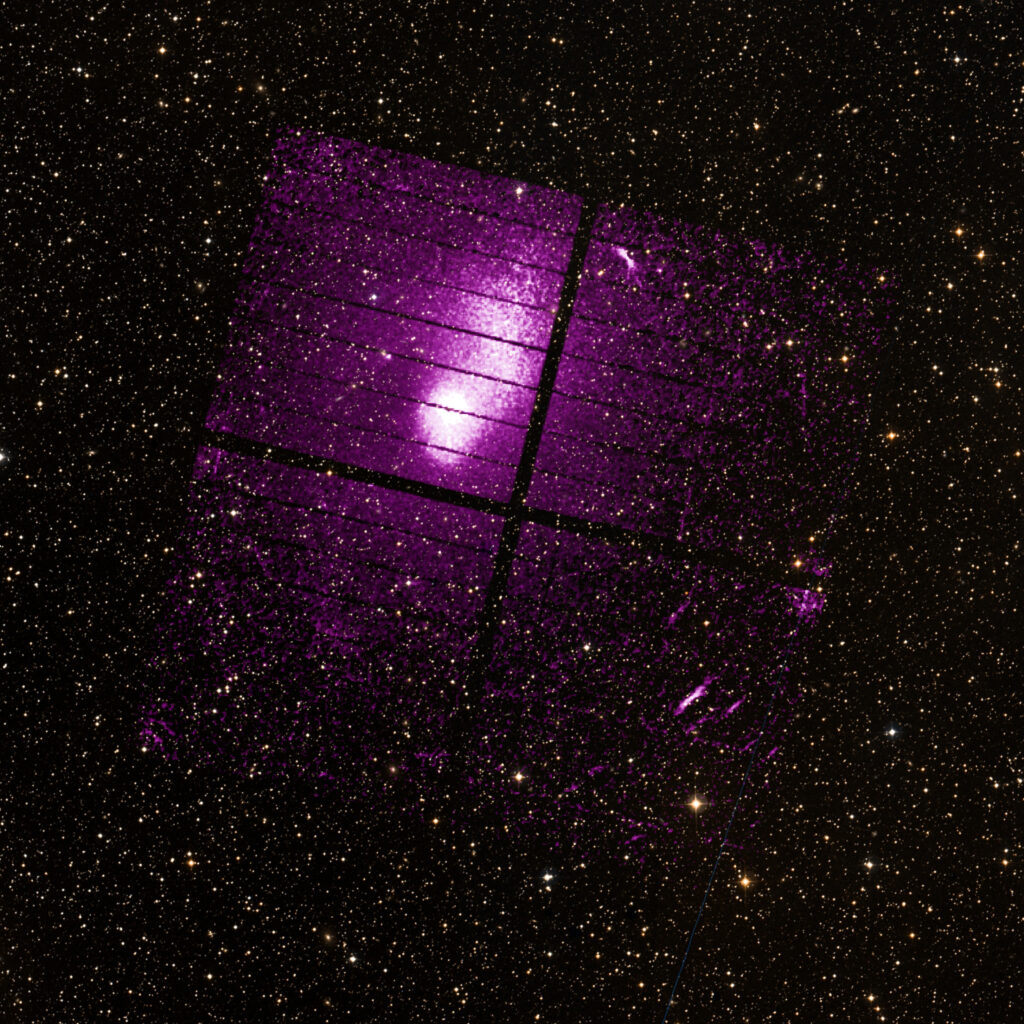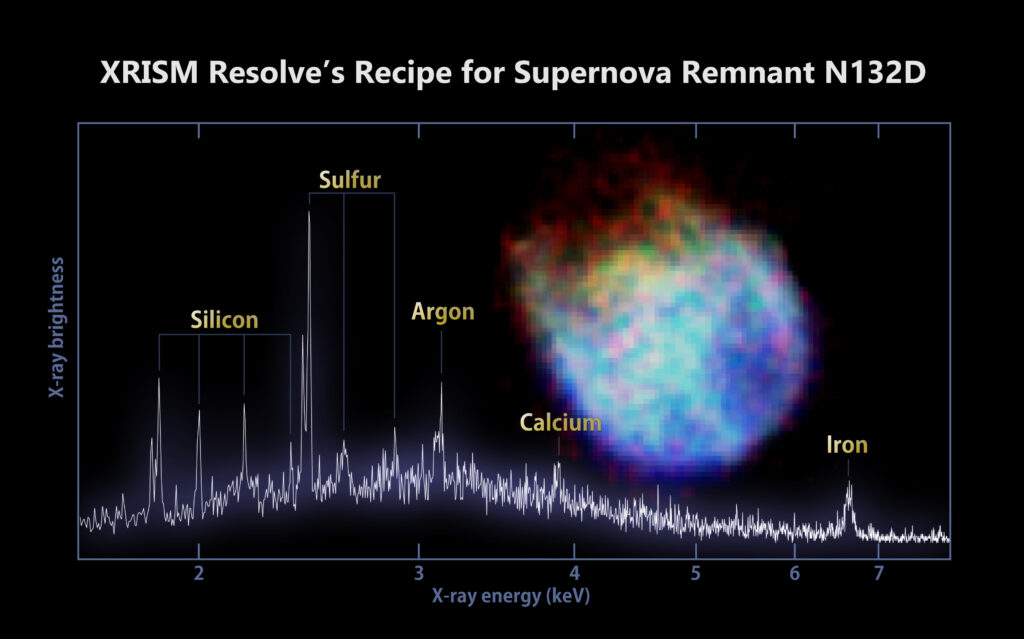Met het maken van haar eerste twee foto’s heeft JAXA’s röntgentelescoop XRISM officieel de mijlpaal First Light bereikt. De plaatjes laten de sterrenstelselcluster Abell 2319 en het overblijfsel van supernova N132D zien, waarmee ze XRISM’s brede blikveld en hoge spectrale resolutie aantonen. SRON heeft het filterwiel en een röntgenbron ter kalibratie van het Resolve-instrument ontwikkeld.
Röntgenfoto’s van het heelal zien er anders uit dan die we kennen van telescopen voor zichtbaar en infrarood licht, zoals Hubble en James Webb. Ze geven ons daarmee unieke informatie over de grootste schouwspellen in de kosmos, omdat röntgenstraling hoogenergetisch licht is dat wordt uitgezonden door de heetste en gewelddadigste objecten en verschijnselen in het universum.

Abell 2319 cluster
XRISM’s eerste beelden zijn gemaakt tijdens de ‘commissioning phase’, waarin engineers alle testen en controles uitvoeren die nodig zijn om ervoor te zorgen dat de telescoop zo goed werkt als mogelijk. De eerste foto geeft een breed blikveld op de sterrenstelselcluster Abell 2319. In paars zien we de röntgenstraling van het gas tussen haar sterrenstelsels—het intracluster medium (ICM)—dat miljoenen graden heet is. Het bestuderen van dit gas helpt astronomen om de totale massa van het cluster te berekenen. Dat geeft ze informatie over het ontstaan en de evolutie van het heelal.
XRISM’s observaties aan clusters van sterrenstelsels biedt ook een inkijkje in de productie en distributie van chemische elementen die we vandaag de dag op aarde vinden. Het ICM is een overblijfsel van stervende sterren gedurende de geschiedenis van het heelal. Door de uitgezonden röntgenstraling te bestuderen gaat XRISM ontdekken welke ‘metalen’ (elementen zwaarder dan waterstof en helium) het bevat en in kaart brengen hoe het universum ermee werd verrijkt.

Supernova remnant N132D
Het tweede plaatje toont de overblijfselen van een zware ster die is ontploft in de Grote Magelhaense Wolk—een satellietstelsel van onze Melkweg. De verschillende kleuren wijzen op röntgenstralen van verschillende energieën, met rood als laagste en blauw als hoogste energie.
Terwijl het Xtend-instrument de foto van de supernova-remnant heeft gemaakt, is het Resolve-instrument complementair door daar een spectrum aan toe te voegen. Dat toont de chemische elementen die aanwezig zijn in N132D. Op die manier kunnen wetenschappers precies aanwijzen waar in het cluster elk element te vinden is.
XRISM kan elk element identificeren door de specifieke energie te meten van de röntgenstralen. Wetenschappers kunnen binnen XRISM’s energiebereik onderscheidt maken tussen de elementen silicium, zwavel, argon, calcium en ijzer. Alleen supernova-explosies produceren deze elementen. Met XRISM kunnen astronomen hun hoeveelheid, snelheid, temperatuur en dichtheid bepalen. Ze kunnen ook een 3D-kaart maken van hun beweging en verdeling als gevolg van de interactie tussen de supernova-remnant en haar omgeving.
Ter vergelijking: de grijze lijn toont hetzelfde spectrum van JAXA’s Suzaku röntgentelescoop. De spectrale resolutie van XRISM is ruim veertigmaal hoger binnen dit energiebereik.
Wat is er gebeurd sinds de lancering?
Sinds de lancering van XRISM op 7 september 2023 zijn engineers en wetenschappers van JAXA aan de slag geweest om de telescoop onderzoeksklaar te maken. Onderdeel daarvan waren het aanzetten en testen van XRISM’s twee instrumenten—Xtend en Resolve.
De telescoop is momenteel in goede conditie. De systemen aan boord werken zoals gepland, waaronder die die de stroomtoevoer, de oriëntatie en de communicatie met de aarde regelen. De ESA-hardware is al vroeg in de ‘commissioning phase’ getest en functioneert naar behoren.
De spectrale resolutie van Resolve—zijn voornaamste wetenschappelijke prestatie-indicator—overtreft de vereisten. Het is echter nog niet gelukt om het vlies te openen dat over de detector zit om hem te beschermen tijdens de lancering. Engineers zijn nog steeds bezig om dit probleem te verhelpen, maar geplande observaties moeten er vanuit gaan dat het vlies blijft zitten. Het N132D spectum laat zien dat baanbrekend onderzoek nog steeds mogelijk is.
De ‘commissioning phase’ wordt eind januari afgesloten. Vanaf februari gaat JAXA de instrumenten kalibreren en hun vermogen op volle kracht gebruiken. Wetenschappers zijn al uitgenodigd om voorstellen in te dienen voor observaties die ze vanaf augustus 2024 kunnen uitvoeren. De deadline is 4 april 2024. Observaties van XRISM zijn complementair aan die van XMM-Newton en worden volgend decennium opgevolgd door de NewAthena röntgentelescoop. SRON is ook onderdeel van die twee missies.
Bijdrage SRON
De Nederlandse bijdrage aan XRISM bestaat uit het filterwiel voor Resolve. Dit draait verschillende filters voor de camera, zodat astronomen de helderheid en golflengte van de inkomende straling naar wens kunnen wegfilteren. Zo zullen ze het Molybdeen grijsfilter gebruiken als een ster of zwart gat meer röntgenstraling afgeeft dan de detector kan uitlezen en kiezen ze het Berillium- of Polyimide-aluminium-filter om bepaalde golflengtes te blokkeren. Een radioactieve ijzer-55 bron zit in het filterwiel ter kalibratie van de röntgencamera. Daarnaast heeft SRON, samen met het bedrijf Exosens (voorheen Photonis), een elektronisch bestuurbare röntgenbron ontwikkeld waaraan de detector continu geijkt wordt.


